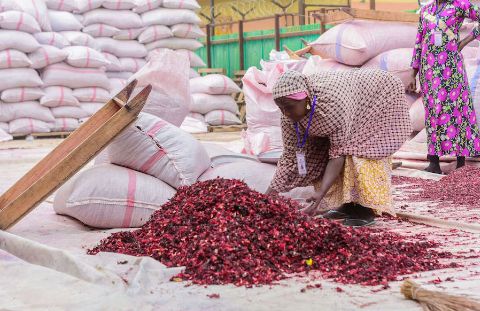By Tomato Stew, I mean stew used to prepare the Nigerian Jollof Rice recipes: Jollof Rice, Coconut Rice, Rice & Beans, etc. This tomato stew also forms the base for the Nigerian Beef & Chicken Stew. I always prepare a large quantity of this tomato stew and store in my freezer. This makes cooking my Nigerian Jollof Rice, Spaghetti Surprise and other meals where I use Tomato Stew so easy.
Please note that this tomato stew does not have any seasoning and other ingredients because it is just a base.
Ingredients for Nigerian Tomato Stew
- 3.2kg (7lbs) fresh Plum Tomatoes (referred to as Jos Tomatoes in Nigeria, tomate pera in Spanish and pomodoro pera in Italian)
- 400g (14oz) tinned tomato paste: (or watery tinned Tomato Puree: 800g)
- Vegetable Oil: a generous quantity
- 2 onions
Important notes on the ingredients
- Tomatoes: Plum tomatoes are the best for the Nigerian Tomato Stew (and other Nigerian recipes) because all the other types of tomatoes either have a very strong taste, have lots of seeds or contain lots of water. You can also use Roma Tomatoes because it is very similar to plum tomatoes.
- Vegetable Oil: There’s always a debate about this one. But I will insist that you need more than enough oil when frying the tomatoes. This is so that the tomatoes will not burn till all the sour taste is gone and the water has dried from the tomatoes. You will pour out the excess oil when the tomatoes are well fried. Just think about this as “sort of” deep frying the tomatoes. Not that you’ll need that much oil but you get the gist.If you don’t use enough oil, your stew will have a sour taste and it will burn even if you stand there stirring frantically 🙁 Cooking should be fun, not tedious. And why worry when you’ll pour out the excess oil when you are done? In my opinion, anybody worried about his/her health should stay away from this stew because it is fried.
This oil you pour out is red hence it is perfect for cooking Egusi Soup, Okra Soup and Ogbono Soup for those who cannot buy or do not want to use palm oil. Once it has cooled down, put it in the fridge or freezer because it will go bad if left on the kitchen counter.
- Tinned tomato paste/puree: The tinned tomato paste sold in Nigeria is usually very thick and concentrated. If you try to fry this tomato paste as is, it will burn straight away. What I normally do is to add some water to it to bring it to the softer consistency. There are other types of tomato purees sold in Europe and the rest of the world and these are usually watery. If that is the only type you can buy, then you need to cook it with the fresh tomato puree (as explained below) to get it to dry up a bit and get rid of the sour taste before frying.One more thing; the tinned tomato paste/puree is optional. Its job is to improve the redness of the tomato stew, making it look richer and more appetizing. If you don’t want to use it, replace with fresh plum tomatoes. In Nigeria, it is common to use tatashe (Nigerian big red peppers) to improve the redness of the tomato stew. Please note that tatashe is not the same as bell peppers.
- Feel free to vary the ratio of fresh plum tomatoes to conc. tomato paste. If you want the stew very red and conc. especially if you want to use it too cook Jollof Rice for a large crowd, increase the quantity of tomato paste you will use for a specific quantity of plum tomatoes.
Before you cook Tomato Stew
- Wash and blend the fresh plum tomatoes. Remember to remove the seeds unless you are sure your blender can grind them very well.
- If using the thick tinned tomato paste that is common in Nigeria, mix it with cold water to get a softer consistency.
- If you are using the watery tinned tomato puree that is common in Europe and other parts of the world, open the tins or packets and set these aside, you’ll need them soon.
- Cut the onions into small pieces.
Cooking Directions
- Pour the fresh tomato blend into a pot and cook at high heat till almost all the water has dried. If you have the watery tinned/boxed tomato puree, add these to the pot and reduce the heat to low. Cook till the water in the tomato puree have dried as much as possible.
- Add the vegetable oil, the chopped onions and the thick tomato puree that you mixed in step 2 above (if it’s the puree you are using). Stir very well.
- Fry at very low heat and stir at short intervals till the oil has completely separated from the tomato puree. A well fried tomato puree will also have streaks of oil, unlike when you first added the oil and it was a smooth mix of the tomato puree and oil. Taste the fried tomato puree to make sure that the raw tomato taste is gone. With time and experience, you can even tell that the tomato puree is well fried from the aroma alone.
- If you are happy with the taste and you are sure that all the water has dried as much as possible, pour out the excess vegetable oil, then add the well fried tomato stew to your cooking.
- If you are not using it immediately, leave to cool down, dish in containers and store in the freezer.
To use, bring out from the freezer and allow to defrost at room temperature and use in your Nigerian Jollof Rice, Nigerian Coconut Rice, Nigerian Rice & Beans, Spaghetti Surprise. Add pepper, seasoning, chicken, beef, fish, turkey etc to get the Nigerian Beef & Chicken Stew used for eating Nigerian Boiled White Rice and other Nigerian staple food.







Appreciating the time and effort you put into your website and detailed information you present.
It’s great to come across a blog every once
in a while that isn’t the same unwanted rehashed material.
Excellent read! I’ve saved your site and I’m including your RSS
feeds to my Google account.
What i do not understood is in fact how you are now not actually much more smartly-appreciated than you might be right
now. You’re so intelligent. You realize therefore significantly in relation to this subject, made me individually
consider it from so many various angles. Its like men and women aren’t interested until it’s something to do
with Woman gaga! Your individual stuffs great.
All the time deal with it up!
My brother suggested I might like this website.
He was entirely right. This post actually made my day. You cann’t imagine simply how much
time I had spent for this info! Thanks!
What’s up, after reading this awesome article i am also glad to
share my familiarity here with friends.
I am really glad to glance at this webpage posts which contains
tons of useful information, thanks for providing these kinds of data.
I am in fact delighted to read this weblog posts which contains plenty of valuable facts, thanks for providing these statistics.
May I just say what a comfort to find somebody who really understands
what they’re discussing on the internet. You certainly understand how to bring a problem to light and make it
important. More people need to look at this and understand this side of your story.
I was surprised you aren’t more popular since you certainly have the gift.
What’s up, after reading this awesome piece of writing i am too happy to
share my familiarity here with colleagues.
Good site you have got here.. It’s difficult to find good quality writing like yours nowadays.
I seriously appreciate people like you! Take
care!!
Hi there, You’ve done an excellent job. I’ll definitely digg it and for my part
recommend to my friends. I am confident they’ll be benefited from
this site.
Can I simply just say what a relief to discover
someone that genuinely knows what they are discussing on the web.
You certainly know how to bring an issue to light and make it important.
More and more people ought to read this and understand
this side of your story. I was surprised you’re not more popular given that you certainly possess
the gift.
Thank you for every other informative website. The place else
may I get that type of info written in such a perfect approach?
I’ve a project that I’m just now working on, and I’ve been at the glance out for such information.
Hello there! I know this is kind of off topic but I was wondering
which blog platform are you using for this website?
I’m getting fed up of WordPress because I’ve had
problems with hackers and I’m looking at alternatives for another platform.
I would be great if you could point me in the direction of a good platform.
مشاور مالی و مالیاتی خبره
My programmer is trying to convince me to move to .net from PHP.
I have always disliked the idea because of the costs. But he’s tryiong none the less.
I’ve been using WordPress on a number of websites for about a year and am anxious about switching to another platform.
I have heard excellent things about blogengine.net.
Is there a way I can import all my wordpress posts into it?
Any kind of help would be greatly appreciated!
Pretty! This has been an incredibly wonderful post.
Thank you for providing these details.
Somebody essentially help to make severely articles I would state.
This is the very first time I frequented your web page and thus far?
I surprised with the analysis you made to make this actual post extraordinary.
Great activity!
You have made some really good points there.
I checked on the net for additional information about the issue and found most individuals will go along with your
views on this website.
ردیاب خودرو نظرات و دزدگیر و ردیاب
خودرو و قیمت ردیاب ماشین وایزر و ردیاب خودرو
تیبا و ردیاب های ماشین و ردیاب خودرو تلتونیکا مدل fmb202
Every weekend i used to pay a quick visit this web site,
because i wish for enjoyment, as this this site
conations genuinely nice funny stuff too.
Hi, after reading this amazing piece of writing i am as well delighted to share my experience here with mates.
you are really a just right webmaster. The site loading velocity is
incredible. It sort of feels that you’re doing any
distinctive trick. Moreover, The contents are masterpiece.
you’ve done a fantastic process on this matter!
Wow! Finally I got a weblog from where I be capable of genuinely obtain helpful information regarding my study
and knowledge.
hello!,I like your writing so so much! share we keep up a correspondence more about your article on AOL?
I need a specialist in this space to unravel my problem.
May be that is you! Looking ahead to look you.
مبل تختخواب شو یکنفره
This web site truly has all the information I wanted
concerning this subject and didn’t know who to ask.
p190
I am regular reader, how are you everybody? This article posted
at this site is truly good.authentic football jerseys
Hi this is somewhat of off topic but I was wanting
to know if blogs use WYSIWYG editors or if you have to manually
code with HTML. I’m starting a blog soon but have no coding experience so I wanted to get advice from someone with experience.
Any help would be enormously appreciated!cheap football jerseys China
Wow, marvelous blog layout! How long have you been blogging for?
you made blogging look easy. The overall look of your web site is wonderful, let alone the content!
cheap NBA jerseys
Hi there Dear, are you really visiting this site on a regular basis, if so then you will absolutely obtain pleasant know-how.cheap basketball jerseys
Oh my goodness! Awesome article dude! Many thanks, However I am experiencing
problems with your RSS. I don’t understand why
I can’t join it. Is there anyone else getting similar RSS problems?
Anyone that knows the answer will you kindly respond?
Thanx!!discount mlb jerseys China
Greetings! Very useful advice in this particular article!
It is the little changes that will make the most important changes.
Thanks a lot for sharing!wholesale mlb jerseys free shipping from China
What’s Happening i am new to this, I stumbled upon this
I’ve discovered It absolutely useful and it has helped me out loads.
I’m hoping to give a contribution & assist different customers like
its aided me. Great job.discount nhl jerseys China
I read this article fully concerning the difference of
latest and previous technologies, it’s amazing article.wholesale football
jerseys from China
Undeniably believe that which you said. Your favorite reason seemed to be on the web the easiest thing to
be aware of. I say to you, I definitely get irked while people think about worries that
they just do not know about. You managed to hit the nail upon the top
as well as defined out the whole thing without having side effect , people can take a signal.
Will probably be back to get more. Thanks
5382
Thanks for one’s marvelous posting! I truly
enjoyed reading it, you might be a great author. I will make certain to bookmark
your blog and may come back very soon. I want to encourage you
to continue your great job, have a nice evening!cheap hockey jerseys from China
I was very pleased to find this page. I want to to thank you
for your time due to this wonderful read!! I definitely
loved every part of it and I have you bookmarked
to look at new stuff in your website.wholesale nfl jerseys from China
Does your website have a contact page? I’m having a tough time locating it but, I’d like to
shoot you an e-mail. I’ve got some ideas for your blog
you might be interested in hearing. Either way, great blog and I look forward to seeing it
grow over time.wholesale mlb jerseys China
Great blog here! Additionally your web site loads up very fast!
What host are you the usage of? Can I get your affiliate hyperlink to your host?
I desire my website loaded up as fast as yours loldiscount football jerseys
Hey! This is my 1st comment here so I just wanted to give a quick shout out and tell you I really enjoy reading through your articles.
Can you recommend any other blogs/websites/forums that cover the same subjects?
Thank you so much!
post485
Saved as a favorite, I really like your blog!cheap nba jerseys from China
Thanks for sharing your thoughts about cheap jerseys from China.
Regardsauthentic hockey jerseys China
Hiya! Quick question that’s totally off topic. Do you
know how to make your site mobile friendly? My blog looks weird when viewing from
my iphone4. I’m trying to find a template or plugin that might be able to
fix this issue. If you have any recommendations, please share.
Thanks!
wholesale NBA jerseys
My spouse and I stumbled over here different web page and thought I may as well check things out.
I like what I see so now i am following you.
Look forward to looking at your web page repeatedly.wholesale
football jerseys
Thank you for sharing your thoughts. I really appreciate
your efforts and I will be waiting for your further write
ups thank you once again.cheap mlb jerseys
I pay a visit daily some sites and sites to read articles or reviews, however this web site gives quality based posts.wholesale mlb jerseys China
Hi! I could have sworn I’ve visited your blog before but after going
through a few of the articles I realized it’s
new to me. Regardless, I’m certainly pleased I discovered it
and I’ll be bookmarking it and checking back often!discount nfl jerseys China
I am regular reader, how are you everybody? This piece
of writing posted at this website is in fact pleasant.cheap nhl jerseys
Great goods from you, man. I have understand your stuff previous to and you are
just too wonderful. I really like what you have acquired here, certainly like what you’re saying and the way in which you say it.
You make it entertaining and you still care for to keep it wise.
I can not wait to read far more from you. This is really a tremendous web site.wholesale nfl jerseys free shipping
Howdy! Would you mind if I share your blog with my myspace
group? There’s a lot of folks that I think would really enjoy your content.
Please let me know. Cheerswholesale football jerseys from China